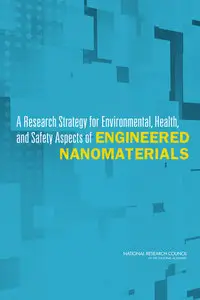A Research Strategy for Environmental, Health, and Safety Aspects of Engineered Nanomaterials
Committee to Develop a Research Strategy for Environmental, Health, and Safety Aspects of Engineered Nanomaterials; National Research Council
NAS Press | 2012 | ISBN: 0309253284 9780309253284 | 173 pages | PDF | 7 MB
Committee to Develop a Research Strategy for Environmental, Health, and Safety Aspects of Engineered Nanomaterials; National Research Council
NAS Press | 2012 | ISBN: 0309253284 9780309253284 | 173 pages | PDF | 7 MB
This issue presents a strategic approach for developing the science and research infrastructure needed to address uncertainties regarding the potential EHS risks of ENMs. The report summarizes the current state of the science and high-priority data gaps on the potential EHS risks posed by ENMs and describes the fundamental tools and approaches needed to pursue an EHS risk research strategy.
The book also presents a proposed research agenda, short-term and long-term research priorities, and estimates of needed resources and concludes by focusing on implementation of the research strategy and evaluation of its progress, elements that the committee considered integral to its charge.
The nanotechnology sector, which generated about $225 billion in product sales in 2009, is predicted to expand rapidly over the next decade with the development of new technologies that have new capabilities. The increasing production and use of engineered nanomaterials (ENMs) may lead to greater exposures of workers, consumers, and the environment, and the unique scale-specific and novel properties of the materials raise questions about their potential effects on human health and the environment.
Over the last decade, government agencies, academic institutions, industry, and others have conducted many assessments of the environmental, health, and safety (EHS) aspects of nanotechnology. The results of those efforts have helped to direct research on the EHS aspects of ENMs. However, despite the progress in assessing research needs and despite the research that has been funded and conducted, developers, regulators, and consumers of nanotechnology-enabled products remain uncertain about the types and quantities of nanomaterials in commerce or in development, their possible applications, and their associated risks.
Contents
SUMMARY
1 BACKGROUND
Overview
Opportunities and Challenges
Commercialization of Engineered Nanomaterials
Present State of Strategic Nanotechnology Environmental, Health, and Safety Research
History of Nanotechnology Environmental, Health, and Safety Research Assessments
Why Another Strategy Is Needed
Scope of this Report
Elements of a Nanotechnology Environmental, Health, and Safety Research Strategy
Prior Approaches to Setting Research Agendas on Other Topics
Goals of this Strategy
References
2 A CONCEPTUAL FRAMEWORK FOR CONSIDERING ENVIRONMENTAL, HEALTH, AND SAFETY RISKS OF NANOMATERIALS
The Nature of the Challenge
Developing a Strategy and a Conceptual Framework
Risk-Assessment Considerations Regarding Nanomaterials
A Conceptual Framework Linked To Risk Assessment
A Life-Cycle and Value-Chain Perspective Leads within the Conceptual Framework
Principles for Identifying and Setting Priorities for Research Needs in the Context of the Conceptual Framework
References
3 CRITICAL QUESTIONS FOR UNDERSTANDING HUMAN AND ENVIRONMENTAL EFFECTS OF ENGINEERED NANOMATERIALS
Introduction
Prior Research-Gap Analysis—An Overview
Research-Gap Analysis and Identification of Critical Research Questions
References
4 NEW TOOLS AND APPROACHES FOR INDENTIFYING PROPERTIES OF ENGINEERED NANOMATERIALS THAT INDICATE RISKS
Characterized Nanomaterials for Nanotechnology-Related Environmental, Health, and Safety Research
Tools, Standardized Characterization Methods, and Nomenclature of Engineered Nanomaterials
Standardized Experimental Protocols for Nanotechnology-Related Environmental, Health, and Safety Research
Exposure Modeling
Models for Predicting Human Health, Organismal, And Ecologic Effects
Exposure to Dose Models
Informatics
References
5 RESEARCH PRIORITIES AND RESOURCE NEEDS
Overview
Adaptive Research and Knowledge Infrastructure for Accelerating Research Progress and Providing Rapid Feedback to Advance Research
Characterizing and Quantifying the Origins of Nanomaterial Releases
Processes Affecting both Exposure and Hazard
Nanomaterial Interactions in Complex Systems Ranging from Subcellular Systems to Ecosystems
Resources for Addressing Research Priorities
References
6 IMPLEMENTING THE RESEARCH STRATEGY AND EVALUATING PROGRESS
Introduction
Infrastructure for Implementation and Accountability
Evaluating and Assessing Progress for Revising the Strategy
Resources
Key Audiences Needed To Implement the Strategy
Concluding Remarks
References
APPENDIXES
A: BIOGRAPHIC INFORMATION ON THE COMMITTEE TO DEVELOP A RESEARCH STRATEGY FOR ENVRIONMENTAL, HEALTH, AND SAFETY ASPECTS OF ENGINEERED NANOMATERIALS
B: IMPLEMENTATION SCENARIOS: INFORMATICS AND INFORMATION SHARING
with TOC BookMarkLinks



